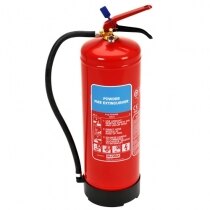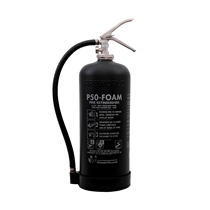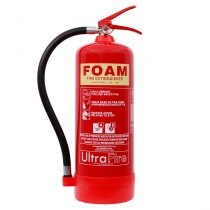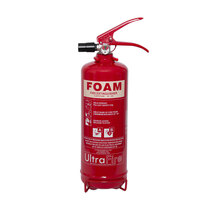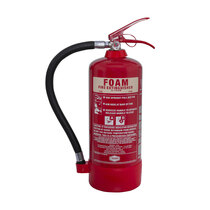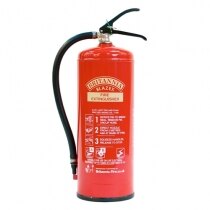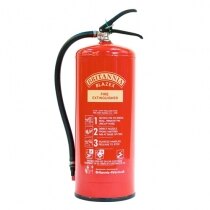-
Contact
Sales & Customer Service
0800 612 6537 support@safelincs.co.uk Live ChatDelivery Enquiries
0800 077 6149 - Resources
Fire & Safety Solutions
CALL OUR TEAM NOW 0800 612 6537
Lines open today 8am - 6pm
FREE Delivery
on marked products
Live Chat - Online
Instant help & Advice
Trade Discounts
and exclusive pricing
0% Credit Available
Open an account now
5 Star Customer Feedback
Fire Extinguishers for Electrical Equipment
When electricity meets fire, choosing the proper extinguisher becomes critical for your safety. Our range of fire extinguishers for electrical equipment provide a solution for tackling electrical equipment hazards in a range of environments. Different types of fire extinguishers you should use on live electrical equipment The answer depends on the voltage, the type of equipment and your specific environment. However, modern testing standards have significantly expanded your options. Traditional choices: Modern innovations: What makes an electrical fire different? Technically, electricity itself doesn’t burn. Often, it is the cable covering or foreign bodies that ignite first. If the supply continues, this is considered a fire involving live electrical equipment. The real danger comes from the continued power supply, which can electrocute anyone using the wrong extinguisher. Why choose our electrical fire extinguishers? Safety first — Every extinguisher in our electrical range meets rigorous safety standards. Water mist and eco-foam undergo 35kV dielectric testing, marked ‘Suitable for use on Live Electrical Equipment up to 1000V at a distance of 1 metre’. Minimal damage — Our dry water mist extinguishers discharge de-ionised water in a mist that cannot carry current, protecting you and your equipment. Versatile protection — Water mist handles Class A, B, and electrical fires; eco-foam adds Class F capability. Service-free options — P50 service-free extinguishers need no servicing for 10 years, only annual visual checks. Our electrical fire extinguisher range includes: Where should you install electrical fire extinguishers? Offices, server rooms, workshops, kitchens, and homes with electrical items all need coverage. When planning, consider risks from laptops, printers, kettles, or washing machines. Professional guidance — Our expert team can assess your electrical risks and recommend the most suitable fire safety equipment. We’ll help you comply with regulations and ensure cost-effective protection. Browse our range here or call Safelincs on 0800 612 6537 for personalised advice. Frequently Asked Questions (FAQs) What’s the difference between an electrical fire and a regular fire? Electricity itself doesn’t burn — surrounding materials ignite. If supply remains live, electrocution risk is high, making standard water extinguishers unsafe unless tested. Can I use water mist extinguishers on live electrical equipment? Yes, if they’ve passed BS EN3-7 dielectric testing. These use de-ionised water mist that doesn’t conduct electricity. Why are CO2 extinguishers still recommended? They don’t conduct electricity and leave no residue, ideal for server rooms and electronics. Ventilation is essential after use. What does ‘di-electrical testing’ mean? It subjects extinguishers to 35,000 volts to ensure safety. Certified units are marked safe for up to 1000V at 1 metre. Can I use the same extinguisher for electrical and other fires? Yes, modern multi-class models (water mist, eco-foam) cover electrical, Class A, B, and even Class F risks.
Read more...
2kg CO2 Fire Extinguisher - Thomas Glover PowerX
With a frost-free horn, wall bracket, and a 5 year warranty, this new 2kg CO2 extinguisher from Thomas Glover is exceptional value for money.
- FREE next working day delivery
- Rating: 34B, electrical
- 5 year manufacturer's warranty
- Kitemarked (BS EN3) and CE marked
This product has been discontinued
Please see our alternative product
9kg Powder Fire Extinguisher - Gloria PD9GA
These units are often found in industrial locations including boat yards, on marine vessels or in harbours. Suitable in areas with flammable materials are present.
- Extinguisher rating 43A, 233B, C
- 10 year warranty
- Kitemarked to BS EN3: 1996
- MED approved - certified for marine use
This product has been discontinued
Please see our alternative product
P50 Service-Free 6ltr Foam Fire Extinguisher - Black Edition
Providing service-free fire extinguisher coverage, the 6ltr Black Edition P50 extinguisher is ideal for the modern home, hospitality sector and office buildings.
- Extinguisher Rating: 34A, 183B
- Safe for use on live electrical equipment up to 1000V
- Black finish to suit modern interiors
- Manufactured in the UK
- Price includes site survey, install and commissioning
This product has been discontinued
Please see our alternative product
P50 Service-Free 9ltr Foam Fire Extinguisher
Fully compliant to all British and European Standards, these maintenance free fire extinguishers are non-corrosive and last 10 years.
- Extinguisher Rating: 43A, 233B
- Safe for use on live electrical equipment up to 1000V
- Kitemarked by BSI to BS EN3
- Over 2kg lighter than standard 9ltr foam extinguishers
- Price includes site survey, install and commissioning
This product has been discontinued
Please see our alternative product
6ltr Foam Fire Extinguisher - UltraFire
One of the most popular extinguishers on the market, a 6l foam offers protection against class A & B fires. Most commonly found in offices and public areas.
- Extinguisher Rating 21A, 144B
- 5 Year Warranty
- Kitemarked to BS EN3: 1996
- CE marked and MED approved
This product has been discontinued
Please see our alternative product
P50 Service-Free 2ltr Foam Fire Extinguisher
A service-free, non-corrosive, Kitemarked extinguisher ideal for small properties and passenger carrying vehicles.
- Extinguisher Rating: 13A, 55B
- Kitemarked by BSI to BS EN3
- Safe for use on live electrical equipment up to 1000V
- Manufactured in the UK
- Optional install and commissioning
This product has been discontinued
2ltr Foam Fire Extinguisher - UltraFire
This compact unit is perfect for installation in both private and public use vehicles as well as being a handy unit to have around the house.
- Extinguisher Rating: 8A,55B
- 5 Year Warranty
- Kitemarked to BS EN3: 1996
- CE marked
This product has been discontinued
3ltr Foam Fire Extinguisher - Jewel Fire Group
A suitable solution for small work spaces or some commercial vehicles, 3ltr foam extinguishers are compact and easy to control.
- Extinguisher Rating 13A, 70B
- 5 Year Warranty
- Kitemarked to BS EN3: 1996
- CE marked
This product has been discontinued
Please see our alternative product
9ltr Foam Fire Extinguisher - UltraFire
With high fire ratings, these extinguisher units are often installed on caravan parks, ideal for extinguishing burning wood, furniture and flammable liquids.
- Extinguisher Rating 27A, 183B
- 5 Year Warranty
- Kitemarked to BS EN3: 1996
- CE marked and MED approved
This product has been discontinued
Please see our alternative product
6ltr Foam Fire Extinguisher - Britannia
This 6ltr foam is perfect for offices, staff rooms, corridors, storage areas and receptions. Often paired with a CO2 fire extinguisher.
- Extinguisher rating: 13A, 144B
- 10 year warranty - Exclusive to Safelincs
- Kitemarked to BS EN 3: 1996 and CE marked
- UK Manufactured
This product has been discontinued
9ltr Foam Fire Extinguisher - Britannia
With fire ratings suitable for tackling burning solid materials and burning liquids, the 9l foam is an ideal extinguisher in office environments.
- Extinguisher rating: 21A, 183B
- 10 year warranty - Exclusive to Safelincs
- Kitemarked to BS EN 3 and CE marked
- UK Manufactured
This product has been discontinued
Please see our alternative product
Page 3 (51 of 51 Products)
What is Di-electric Testing?
Di-electrical testing verifies that even with an incredibly high voltage of 35,000 Volt, no electrical current can flow back to the person discharging the extinguisher on a fire involving live electricity. The test consists of certain test distances between the user and the fire.
Once an extinguisher has passed this stringent test, it is still limited for safety reasons. The limits, which are found on electrically safe extinguishers, are a maximum of 1000 Volt and a minimum distance between the extinguisher and the fire of 1 metre (1000V is four times the voltage used in a domestic premises).
If a liquid extinguishing agent is used on a fire involving live electrical equipment, there is still a risk of a pool forming. The risk of electrocution for the user is reintroduced and increased if they were to stand in the pool. However, it is key to remember that the use of any liquid on live electrical equipment usually leads to immediate fuse-triggering and power is cut off to the electrical device.
Our range of dry water mist extinguishers, although a liquid based extinguishing agent, discharges de-ionised water in an extremely fine mist by a specially designed spray nozzle. Pooling is almost impossible by this method, and de-ionised water cannot carry an electrical current which reduces the risk of electrocution even further with minimum damage to the equipment.
What is an Electrical Fire?
Technically, there is no such thing as an electrical fire, as electricity itself does not burn and neither do the cable cores and other conductors. However, the electrical current can heat up other materials that may be on top of the cables or around the plug sockets, and this would be the start of what is considered to be an electrical fire.
Often, it is the cable covering or even foreign bodies in the electrical equipment that start to burn first. If the electrical supply to the equipment on fire continues, this is what is considered to be a fire involving live electrical equipment. The use of, for example, a simple water extinguisher could then lead to electrocution of the individual fighting the fire.
Therefore, when planning for extinguishers and what types you may require for your business or home, you must consider all risks, including what electrical equipment you may have to use, such as, laptops, printers, kettles, or washing machines.
Our section of electrically safe extinguishers will help you select a suitable extinguisher for your building or application.
What Extinguishers are Suitable for Live Electrical Equipment?
Historically and traditionally, CO2 fire extinguishers have been the number one choice for fire risks involving electrical equipment, as the gas extinguishing agent does not carry electricity. However, unless contained, CO2 gas can drift off and disperse quickly and the fire can re-ignite.
Powder extinguishers have also been known to be used on these types of fires, as they are powerful and do not conduct electricity. However, powder extinguishers are not recommended for use indoors any longer, as they can cause inhalation issues and impair the visibility of the escape route.
Newer types of extinguishing agents, such as water mist and eco-foams, have been developed in such a manner to overcome traditional solutions and provide an environmentally safe alternative.
Water Mist extinguishers have been specially developed to provide effective fire-fighting capabilities with little to no damage to property. With de-ionised water and a specially designed spray nozzle discharging a very fine mist blanket, this extinguisher does not create pools of liquid when tackling a fire, further protecting the user from both the fire and subsequent electrocution.
Eco-foams, a more recent developed extinguishing agent which overcomes the discontinuation of AFFF foams, has been developed to provide a solution to most fire classes including electrical. The extinguishing agent is free from harmful PFAS chemicals, making it a more environmental choice, as well as having high ratings for other fire classes.





















